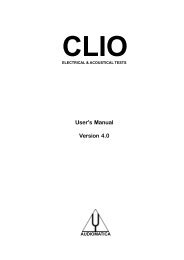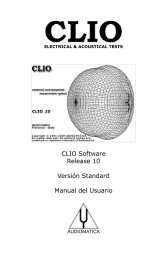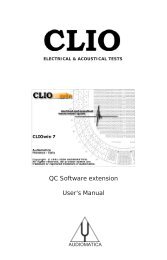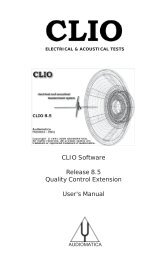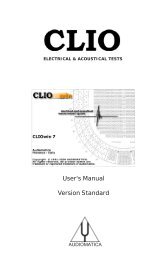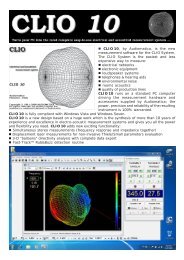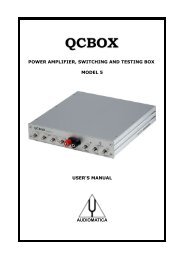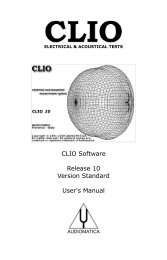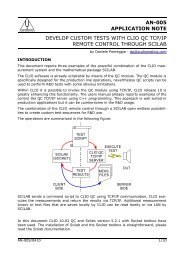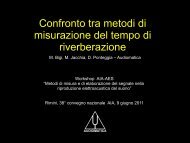measuring maximum subwoofer output according ansi/cea-2010 ...
measuring maximum subwoofer output according ansi/cea-2010 ...
measuring maximum subwoofer output according ansi/cea-2010 ...
Create successful ePaper yourself
Turn your PDF publications into a flip-book with our unique Google optimized e-Paper software.
MEASURING MAXIMUM SUBWOOFER OUTPUT ACCORDING CEA-<strong>2010</strong> (ANSI)<br />
Let's start with a preliminary measurement (Figure 7): using the CEA-burst options<br />
we generate a 6.5 cycles 100 Hz burst, with a safe <strong>output</strong> level of -32 dBu. Pressing<br />
F8 key we increment the level in 1 dB steps until we reach a suitable signal-to-noise<br />
ratio.<br />
Then we open the FFT menu and start an FFT analysis on channel A with the internal<br />
trigger option enabled. We chose dBSPL as Y scale unit and 1/12 octave as smoothing<br />
2 . The minimum FFT size should be of 32768 points, since the lowest ANSI/CEA-<br />
<strong>2010</strong> test frequency is 20 Hz, which means, for a 6.5 cycles, a duration of around 325<br />
ms. The result of this FFT analysis is on the upper graph of figure 7, where the effect<br />
of room reflections is clearly visible.<br />
At this point we enable the ANSI/CEA-<strong>2010</strong> option in the FFT menu settings, as previously<br />
shown in figure 5. Looking at the lower graph of figure 7 the effect of the time<br />
windowing is clear. While in this case the room reflections are not completely rejected,<br />
the spectrum is easier to read and not corrupted by reflections.<br />
We are now ready to go on with the ANSI/CEA-<strong>2010</strong> test procedure starting with the<br />
20 Hz test frequency. Again we start with a convenient low <strong>output</strong> level of -24 dBu,<br />
and carefully increment the level in 1 dB steps until the FFT spectra do not reach the<br />
ANSI/CEA-<strong>2010</strong> limit. Once the limit is reached we stop the generator and annotate<br />
the “CEA pressure peak” level reported by the slave meter readout.<br />
Then we repeat the process for the other test frequencies: 25, 31.5, 40, 50, 63 Hz.<br />
Figure 8: CLIO 10 running ANSI/CEA-<strong>2010</strong> test<br />
2 The 1/12 octave smoothing is requested by the ANSI/CEA-<strong>2010</strong> standard.<br />
8/12 www.audiomatica.com



